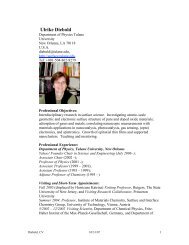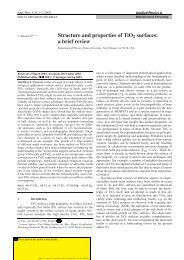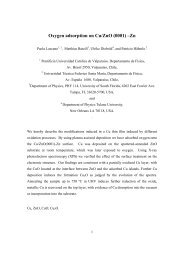The surface science of titanium dioxide - Niser
The surface science of titanium dioxide - Niser
The surface science of titanium dioxide - Niser
Create successful ePaper yourself
Turn your PDF publications into a flip-book with our unique Google optimized e-Paper software.
74 U. Diebold / Surface Science Reports 48 (2003) 53±229<br />
<strong>The</strong> directions <strong>of</strong> the calculated relaxations agree in (almost) all the theoretical papers with the<br />
experimentallydetermined coordinates. <strong>The</strong> quantitative agreement is not as good as one could expect<br />
from state-<strong>of</strong>-the art ab initio calculations, however. As Harrison et al. [64] pointed out, the extensive<br />
experience <strong>of</strong> calculations on bulk oxides which has been built up in recent years leads one to expect<br />
that DFT and HF calculations will reproduce experimental bond lengths to somewhat better than 0.1 AÊ .<br />
For example, the bulk structural parameters <strong>of</strong> TiO 2 rutile agree better than 0.06 AÊ using s<strong>of</strong>t-core ab<br />
initio pseudopotentials constructed within the LDA, and a plane-wave basis [104].<br />
In particular, all the calculations ®nd a much smaller relaxation for the position <strong>of</strong> the bridging<br />
oxygen atom. A possible reason for this disagreement was given by Harrison et al. [64]. All the<br />
theoretical results listed in Table 3 are strictlyvalid onlyat zero temperature. It is conceivable that<br />
strong anharmonic thermal vibrations at the TiO 2 (1 1 0) <strong>surface</strong> cause the discrepancybetween<br />
experimental and theoretical results. However, molecular dynamics simulations using the Carr±<br />
Parinello approach [105] found that the average position in dynamic calculations is only relaxed by<br />
0.05 AÊ rather than by0.27 AÊ , discarding this explanation. Instead, it was suggested that the O atom<br />
might relax laterallyso that it is displaced into an asymmetric position.<br />
Based on these theoretical results, the ®nite temperature has to be taken into account for a proper<br />
evaluating diffraction results. Hopefully, future experiments will show whether a better agreement with<br />
theoreticallypredicted relaxations can be achieved. When considering <strong>surface</strong> reactions, one also needs<br />
to depart from a static picture <strong>of</strong> this and other oxide <strong>surface</strong>s, and has to keep in mind the substantial<br />
distortions and bond length changes that take place during such large-amplitude vibrations.<br />
It is now well-known that adsorbates <strong>of</strong>ten have a signi®cant in¯uence on `re-relaxing' the <strong>surface</strong>.<br />
Computational studies, e.g. the one given in [106] for the adsorption <strong>of</strong> Cl, clearlyshow strong effects<br />
upon adsorption. Onlya few experimental exist so far. For example, Cu overlayers on TiO 2 (1 1 0) cause<br />
the Ti atoms at the Cu/TiO 2 (1 1 0) interface relax back to the original, bulk-like positions. <strong>The</strong> O atoms<br />
relax even stronger, which was attributed to Cu±O bonding [107].<br />
2.2.1.3. Appearance in STM and AFM. Naturally, scanning probe techniques are extremely useful tools<br />
for studying atomic-scale structures at TiO 2 and other metal oxide <strong>surface</strong>s, where local changes in<br />
stoichiometryor structure can severelyaffect <strong>surface</strong> reactivity. On TiO 2 (1 1 0), STM and, more recently,<br />
non-contact AFM, have been used bymanydifferent groups. <strong>The</strong>se techniques have provided valuable<br />
and verydetailed insight into local <strong>surface</strong> structure. However, the interpretation <strong>of</strong> STM images <strong>of</strong><br />
oxides is somewhat challenging because <strong>of</strong> strong variations in the local electronic structure, and because<br />
tips can easily`snatch' a <strong>surface</strong> oxygen atom, which can cause a change in tip states and result in<br />
`artifacts' in STM images. <strong>The</strong>re is now consensus among different groups on what is `really' observed<br />
with STM, at least under `normal' operating conditions.<br />
<strong>The</strong> dominant tunneling site on TiO 2 (1 1 0) <strong>surface</strong>s has been subject to some debate in the past. In<br />
principle, there is uncertaintyas to whether the image contrast is governed bygeometric or electronicstructure<br />
effects. For TiO 2 , atomic-resolution STM is <strong>of</strong>ten onlysuccessful when imaging unoccupied<br />
states (positive sample bias) on reduced (n-type) samples. In reduced TiO 2 crystals, the Fermi level is<br />
close to the conduction-band minimum (CBM) in the 3 eV gap, and electronic conduction occurs<br />
predominantlythrough high-lying donor states [78]. Under a typical bias <strong>of</strong> ‡2 V, electrons can thus<br />
tunnel from the tip into states within 2 eV above the CBM, and be conducted awayfrom the <strong>surface</strong>.<br />
On the one hand, these CBM states have primarilycation 3d character (the valence band having<br />
primarilyO 2p character, see Section 3) so that one might expect to image the metal atoms as the







